SS
Uruguay, Brazil
& Argentina
- The “Good Neighbor Fleet” managed by Moore-McCormack Lines
Please
Note: Firefox & Google Chrome other search engines may not suitable
Please
use Internet
Explorer - Google for this page to load perfectly!

Click
the logo above to reach ssMaritime FrontPage & “Ship of the Month”
With
Reuben Goossens
Maritime
Historian,
Author, Cruise‘n’Ship Reviewer and Maritime Lecturer
Please
Note:
All ssMaritime and other related maritime/cruise sites are 100% non-commercial
and privately owned. Be assured that I am NOT associated with any shipping or
cruise companies or any travel/cruise agencies or any other organisations!
Although the author has been in the passenger shipping industry since 1960,
although is now retired but having completed over 700
Classic Liners and Cargo-Passengers Ships features I trust these will continue
to provide classic ship enthusiasts the information they are seeking, but
above all a great deal of pleasure!
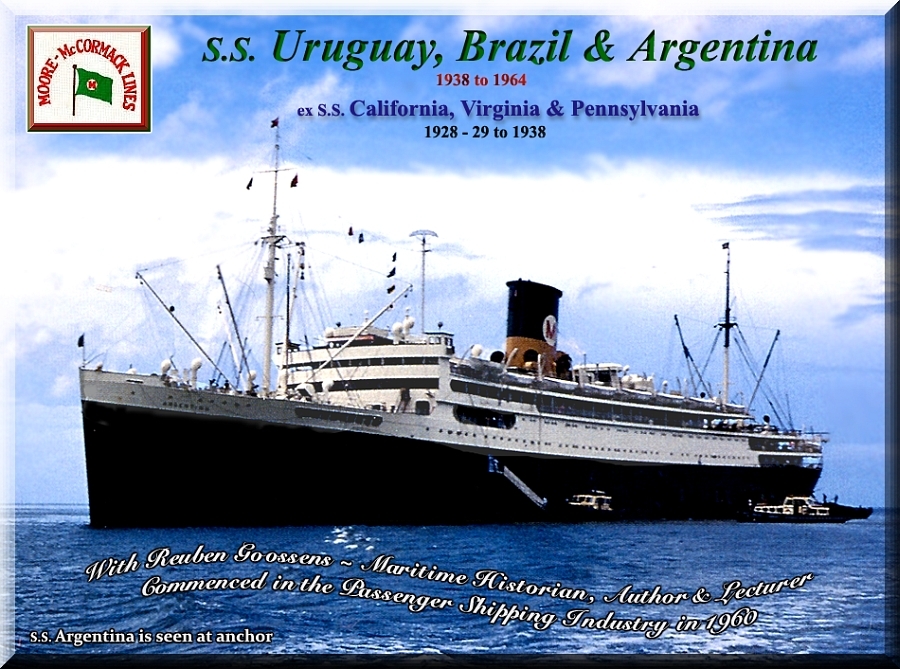
Page
Two
Please Note: Photographs & Images are from the Author’s
private collection, unless otherwise stated.
The three still in perfect condition Panama Pacific Line liners having been sold to
become part of America’s
“Good Neighbor Fleet,” they were sent to be partially refurbished
at “Newport News Shipyards,” or the Bethlehem Shipbuilding
Corporation. Below are their actual details!
1… SS California:
With the Panama Pacific Lines, SS California
having been sold to the “U.S. Maritime Commission” and she was sent
to her original builders “Newport News Shipyards,” where she
received considerable work for her new role for the “American Republics
Line” South America service.
2… SS Virginia:
Like her sister she was also sold to
“U.S. Maritime Commission,” but she was sent to the Bethlehem
Shipbuilding Corporation at the company's Brooklyn Plant at 56th.Street. There
she received much the same work as all three ships received during their first
conversion.
3… SS Pennsylvania:
Just like her earlier sisters she joined the
“U.S. Maritime Commission,” and she was sent to “Newport News
Shipyards” where she received considerable work for her future role.
The work that was undertaken on all three
ships during their first part of their conversion was to have the aft funnel
removed whilst the remaining funnel was enlarged. In addition the ships were
renamed “Uruguay,”
Brazil and Argentina
respectively!
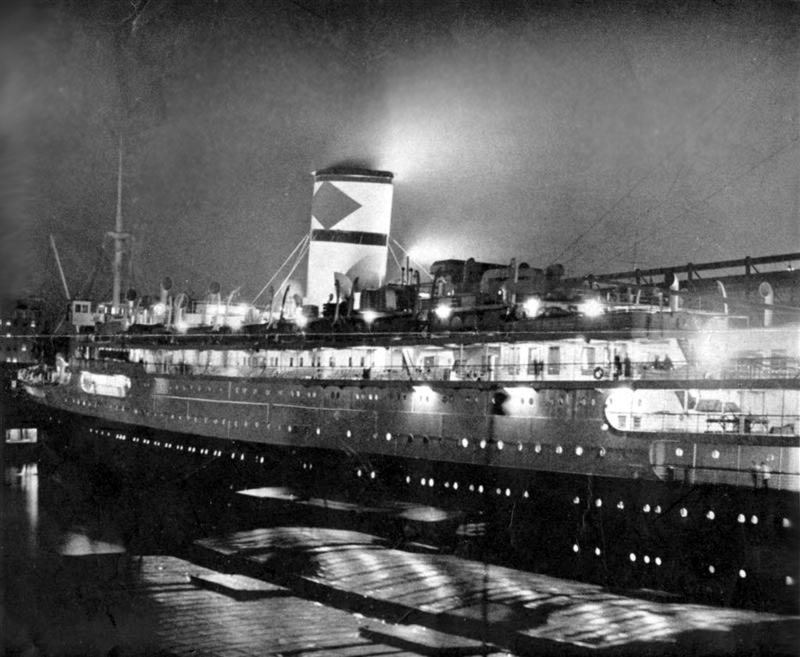
Here we see one of the American Republics Line ships
completed
When work at the two shipyards was completed,
each ship headed for New York
to the Bethlehem Shipbuilding Corporation at the company's Brooklyn Plant at
56th.Street. It would be here, where
considerable internal technical and decorative work would be undertaken. Each
ship would have interior designers come onboard and they would completely
overhaul their interiors and modernise certain parts of each ship, without
losing their historic beauty, such as the Main Lounges and Libraries!
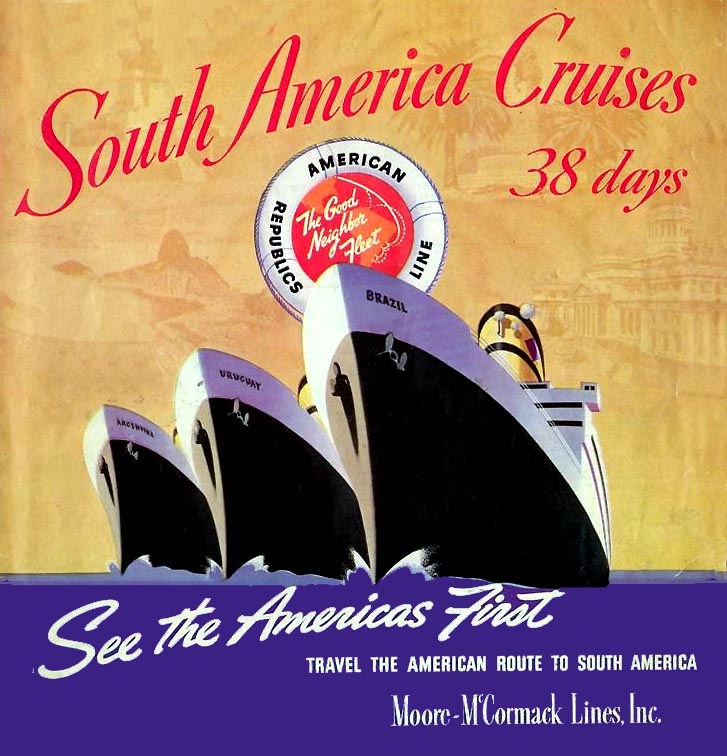
Advanced promotional Brochure
Originally, air conditioning had
only been installed to First Class Cabins and the Dining Room, but now it was
extended to the Tourist Class Dining Room. The renovation also included a new
swimming pool, as well as a complete reconstruction of the after deck in order
to provide a Tourist Class Veranda Café. Throughout the ship, Cabins, Deluxe
Staterooms, and Suites were comprehensively refurbished, whilst passenger
numbers were also extensively reduced. In addition, in order to improve fuel
consumption, new twin-screw propellers installed were.
During the refurbishment, each ship was
completely fireproofed to comply with the new Federal safety regulations, which
had been revised due to the tragic fire that had destroyed the liner Morro Castle in 1934.
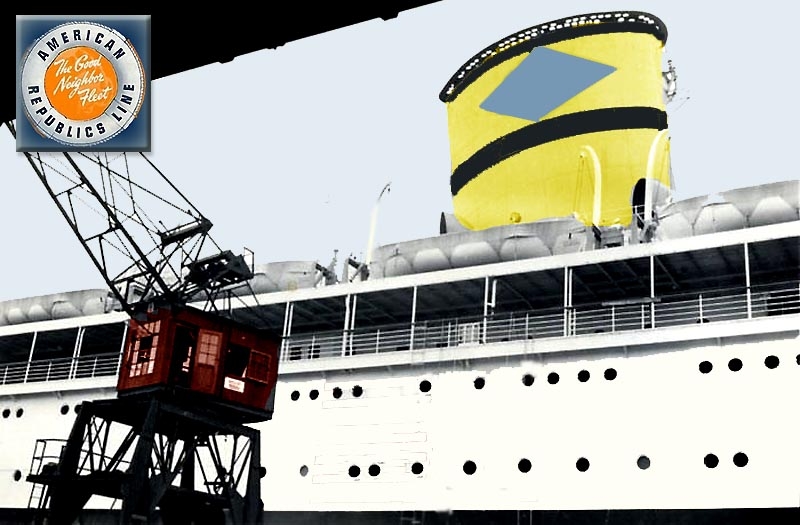
Here we see one on the “American Republics
Line” ships with their new livery
The Argentina had a Pre-War
Passenger Capacity of 475. In addition, the S.S. Uruguay was the Flagship of
the “Good Neighbor Fleet.”
The Brazil
& Uruguay
had a Pre-War Passenger Capacity of 470.
All three ships: Had a crew of 380 and had cargo space of 450,000 Cubic Feet (bale
capacity), with 95,000 Cubic Feet of refrigerated space.
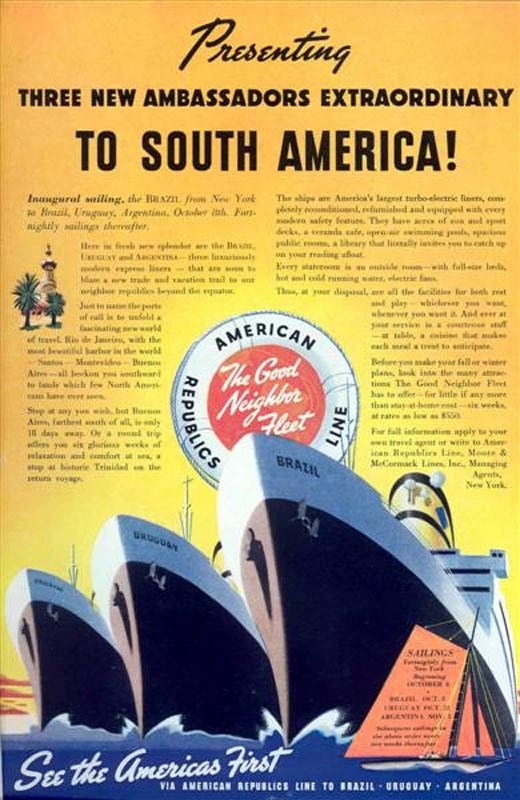 -
-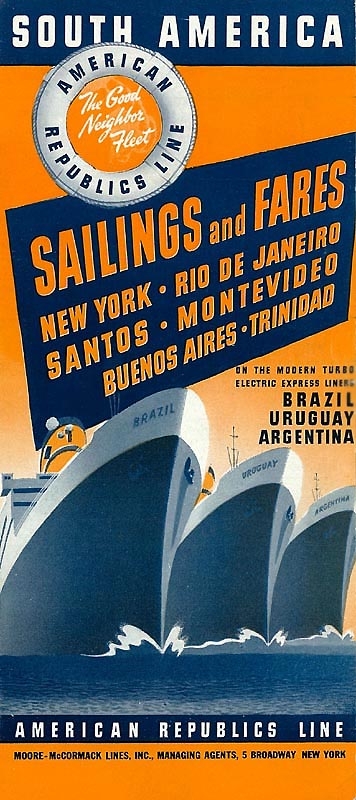
Two “American Republics Line” brochures
released early in 1938
The
Good Neighbor Fleet Commences Services:
SS
Uruguay was the first of the trio to sail for the American Republics Line on
October 4, 1938, the she was operated by Moore & McCormack Line, when she
departed New York on January 11, 1939 and headed for Barbados, Rio de Janeiro,
Santos, Montevideo and Buenos Aires, then returned northbound to Santos, Rio de
Janeiro, and Trinidad, back to New York.
SS Brazil departed New York at noon, on
October 8, 1938 and set sail for Rio de Janeiro,
Santos, Montevideo,
Buenos Aires, and Trinidad and back to New York. The Brazil came
under Moore & McCormack management in December 31, 1938
SS Argentina
departed from New York in November 1938, and
headed for Rio de Janeiro, Santos,
Montevideo, Buenos Aires,
and Trinidad, returning to New York
to do it all over again.
A Mini Photo Album of the ships in their early days:
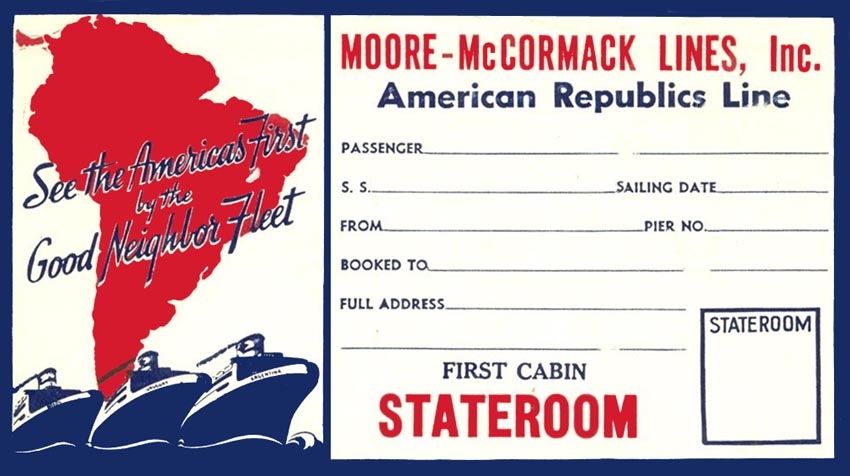
Before
heading off on a voyage, first all suitcases needed a label fully completed!
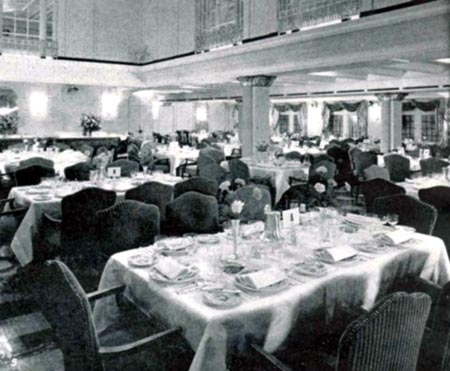 -
-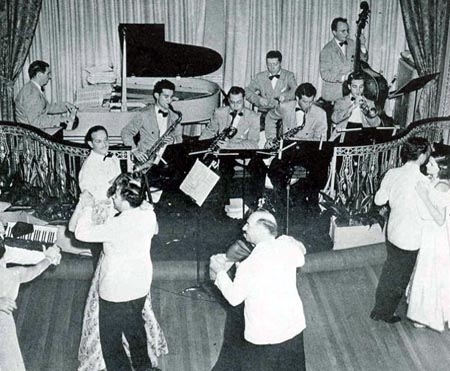
After a
fine meal in the dining Saloon, it would be an evening of dancing or some time
at the bar with friends
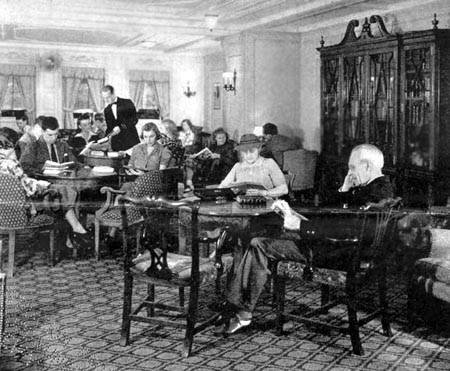 -
-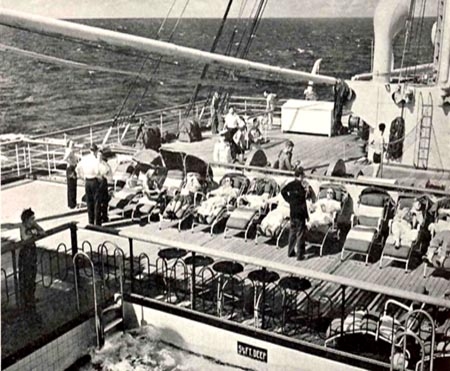
There were
those who would love to read in the Reading Room, or have a swim in the pool
or just sun bake an the Sun Deck, or
enjoy one of the sport events!
The three ships were soon quite popular, and
as America was not involved in the War with the murdering Nazis, leaving the
Europeans, Britain and the Jewish people completely on their own, without any
assistance whatsoever even to the point of not allowing the tragic German ship
the St Louis filled with doomed Jews, most who would end up in death camps,
entry into the US for refugee status!
But The “Good Neighbor Fleet”
would continue their regular passenger services right trough the very end on
1949, when the Japanese attacked!
Below, is what was called a few glimpses of a
Voyage on a “Good Neighbor Fleet” ship.
The author is unknown:
“You leave New York on Friday, at
midnight aboard the either the S.S. Uruguay, the S.S. Brazil or
the S.S. Argentina being the largest, most modern equipped liners in
regular service between the United States and its neighbor
republics, whose names they bear. Ahead lays the equator where Neptunus Rex, father of the sea, who will initiate you into
the mysteries of his realm. And beyond is a wondrous land few North
Americans really know much about. Twelve days of rest and fun at sea bring
you to one of the most beautiful ports on the Seven Seas, the mountain-rimmed harbor
of Rio de Janeiro. Here you go ashore for tours or a fun evening, as you wish.
Then overnight the ship will sail for Santos for
another day of scenic discoveries next comes exciting Montevideo,
and on the eighteenth day you arrive at our final destination, Buenos Aires.
Homeward bound, back on our ship having spent
four exotic days in romantic Argentina,
you look forward to revisiting Santos and Rio for further new sights and thrills to add to those we
saw on your southbound journey and also to see the
historic Isle of Trinidad. Of course just to rest in ultimate comfort of the
ship, which has become your luxurious home at sea, and to take still further
advantages of its superb facilities for fun and carefree living to the max!
Although you may have spent a night or two at the smartest hotels in fastidious
Buenos Aires,
you find your stateroom quite equal in
comfort. Yes, you have wined and dined in the most fashionable restaurants
ashore, but you will eagerly anticipate the equally delectable cuisine that you
have been enjoying onboard your ship. And how idyllic it seems to have your
well-being so courteously attended to again by the staff and crew that have
served you so capably since you left New
York. This is the half-way
point on a round-trip cruise that covers well over 12,000 miles. And by now you
are probably wishing it might never end.
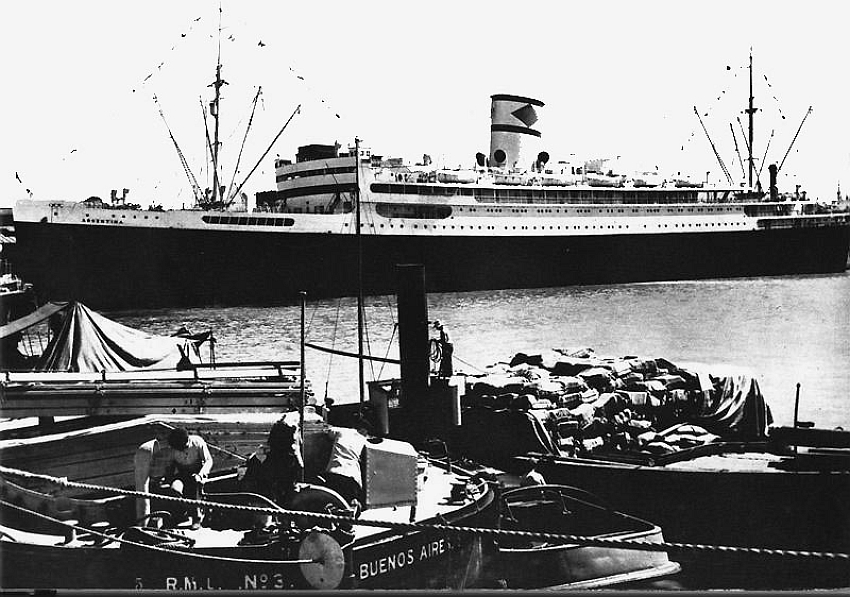
The
“American Republics Lines” SS Argentina is seen berthed at one of
her ports of call
Aboard these great liners of The “Good
Neighbor Fleet” the opportunities for enjoying a life of perfect ease and
rare good times are literally limitless. Like floating modern cities, they
cater to your every need and whim. On each ship there‘s a doctor, nurses
and excellent hospital facilities, yes there is even a “Dorothy Gray” beauty salon, as well as a Shop to
provide you with personal necessities, souvenirs of your vacation and ship
memorabilia, as well as to keep you supplied with film, but also to develop and
print your stills without delay. And for those who do not take movies of their
own, or would like to add to their personal recordings, expertly photographed
reels of many interesting shipboard activities will be available to passengers
at a modest cost. Even if you forget to bring your camera, you may rent either
one or purchase one duty free aboard.
Onboard one of the tree fine liners you will
have thirty-eight of the most memorable days of your life! This is a
wonderful and a glorious vacation, for The “Good Neighbor
Fleet” does offer a new kind of adventure; Be assured these fine ships
will offer luxury, comfort and wonderful fun afloat, discovering many glamorous
and new sights to experience ashore at all the exiting ports!”
WWII:
Like most shipping companies, be it European
and British Shipping Lines, and of course the vast majority of American
passenger liners would be in big demand for the use as Troop or Hospital ships,
etc, and serve during the war! However the three ships of the “Good
Neighbor Fleet” were not required during the early part of the War and
thus they continued on their regular services, but with a large American flag
painted on the sides of their hulls, as America was not involved in the
war!
But then came Japan’s attack on Pearl
Harbour on December 7, 1941 and the very next day, December 8, the United
States declared war against Japan.
This being the case, at the start of January
1942, the SS Uruguay, Brazil and the Argentina were requisitioned to become
“United States Army Transport ships” (USAT) for the “War
Shipping Administration,” and they headed off to their respective docks
for not just their new paint work, being that drab wartime grey, but also to
have their interiors specially fitted with departments for troops in a special
part of the ship, but still retaining passenger space, as well as having some
other required works.
USAT Uruguay:
War service for the Transport ship Uruguay was vast and varied, as for
her very first voyage the USAT Uruguay filled with U.S.
troops, departed Brooklyn, N.Y., and sailed via Panama,
Bora Bora (Polynesian
Islands, Tahiti) to Auckland,
New Zealand, then continuing
to Melbourne Australia. From Melbourne she
turned back and sailed to Wellington then to Auckland and headed for Halifax
and sailed on and she visited countless ports, such as Swansea, Oran,
Casablanca, Bermuda, Brisbane, Fremantle, Bombay, Sydney, Hobart, Cape Town,
Liverpool, the Clyde, the Mersey, Southampton, United Kingdom, the Solent, Le
Havre, Leghorn, Gibraltar, Manila, Leyte, Honolulu, Manila, and Yokohama.
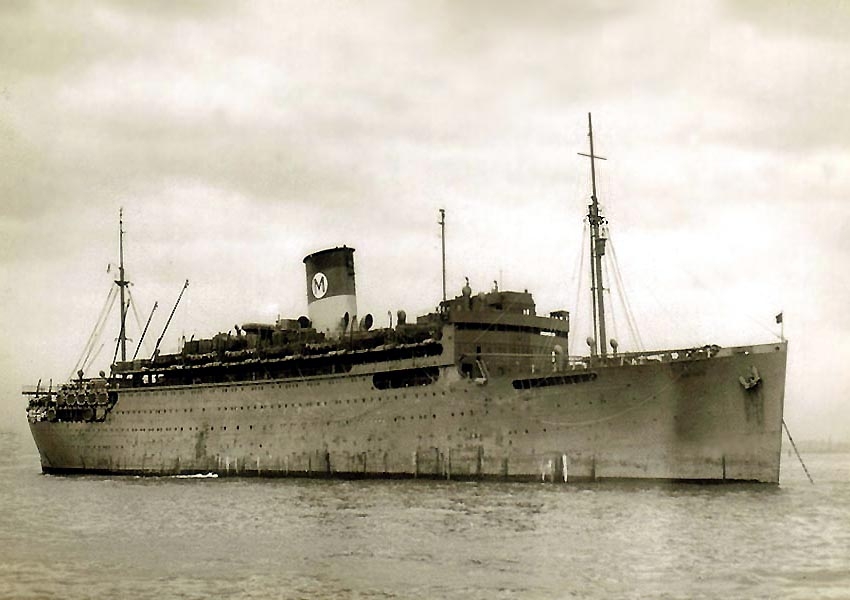
The
Transport ship USAT Uruguay is seen at anchor at some port
Photographer is
unknown - Please see photo notes at bottom of this page
Then on February 12, 1943 the SS
Uruguay was rammed by a Navy tanker the U.S.S. Salomonie,
which created a 70-foot wide gaping hole in the Uruguay. Tragically some thirteen
soldiers were killed as well as fifty soldiers having been badly
injured. A temporary bulkhead was constructed and three days later the Uruguay was
brought into a safe harbour. Captain Albert P. Spaulding as is recorder
did save many lives, also his ship and her cargo. At a later
date, the President of the United States took great pleasure
in presenting the “Merchant Marine Distinguished Service Medal” to
Captain Albert P. Spaulding, Master of USAT Uruguay.
USAT Brazil:
Like her sisters the SS Brazil was also
requisitioned to become “United States Army Transport ships” (USAT)
for the “War Shipping Administration.” When she was ready the USAT
Brazil departed Charleston, South Carolina on March 19, 1942 and headed for Karachi, India, carrying a good 4,000 American troops
from a number of different Army units. She completed this voyage on May 12. She
also operated voyages to Casablanca, Morocco, and on October 22, 1944 she sailed from
Staten Island, New York,
with the 290th.Infantry Regiment onboard,
arriving at Swansea, Wales on November 1, 1944. The
290th.went on to fight in three major campaigns,
at the Ardennes, known as the “Battle of
the Bulge” in Central Europe, and the Rhineland.
On September 26, 1945 the USAT Brazil arrived
at San Francisco with an amazing 4,682 troops
aboard the ship having crossed the Pacific from Australia
and other destination’s bringing America’s fighting men and women home!
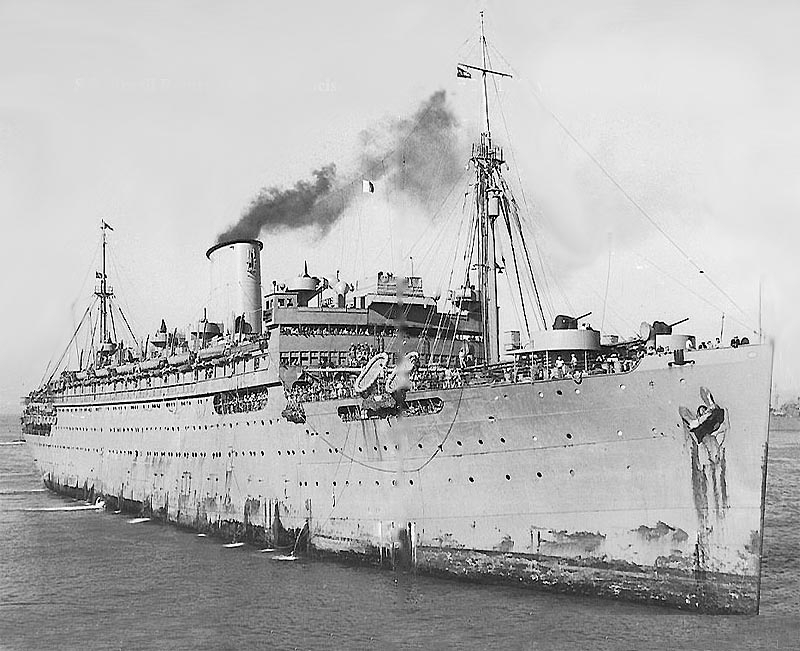
The Brazil
is seen approaching San Francisco
on September 26, 1945 packed with soldiers!
Photographer
is unknown - Please see photo notes at bottom of this page
Thankfully USAT Brazil survived the War
with only minor mishaps.
USAT Argentina:
The S.S. Argentina, with 200
passengers, was to depart at 1.00 pm on January 3, 1942 for South
America; however the Navy requisitioned the ship on January 2,
1942. Even though cargo had already been loaded in the holds and around
200 passengers had booked a voyage when the Navy and the Maritime Commission
notified the shipping company to cancel the sailing. Passengers were
rapidly notified either by word of mouth, as some where already at the wharf
and others yet to arrive by telegram or telephone. Officials refused to
discuss the reason for the sudden action taken by the advice of the War
Office. The ship, like her two sisters, became a “United States Army
Transport” ship “USAT” for the “War Shipping
Administration.” The S.S. Argentina, with 200 passengers, was
set to sail at 1 pm on January 3, 1942 for South America,
but the Navy took over the ship on January 2, 1942. Even though cargo had
already been loaded in the holds and around 200 passengers had booked a voyage
when the Navy and the Maritime Commission notified the shipping company to
cancel the sailing. Passengers were rapidly notified either by word of
mouth, as some where already at the wharf and others yet to arrive by telegram
or telephone. Officials refused to discuss the reason for the sudden
action taken by the advice of the War Office. The ship, like her two
sisters, became a “United States Army Transport” ship
“USAT” for the “War Shipping Administration.”
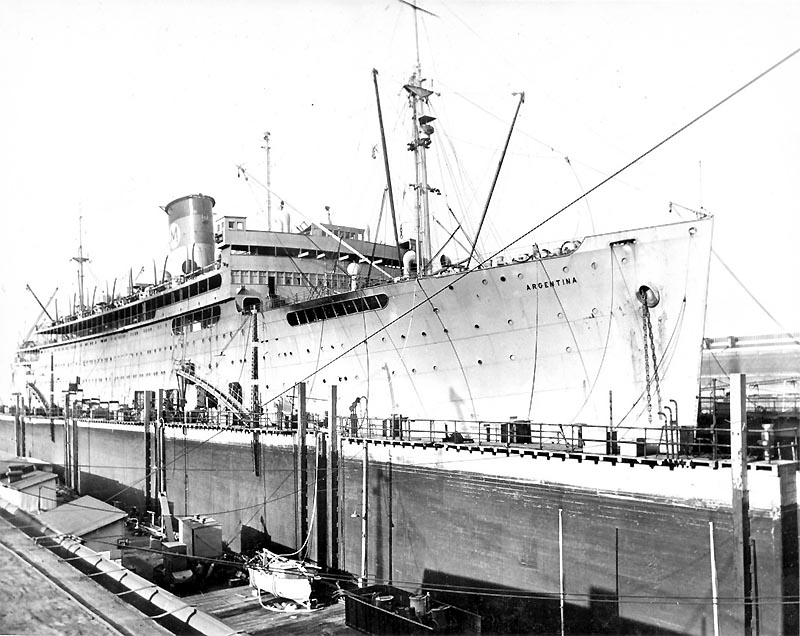
USAT Argentina is seen in Dry-Dock being made ready
for her trooping duties
Photographer
is unknown - Please see photo notes at bottom of this page
The Argentina arrived at New York on
January 8, and after having been made ready she departed again on January 23,
and she was given the role as flagship of six troop carriers, as well as a
number Naval escorts. The fleet arrived in Melbourne, Australia
on February 27, 1942. She returned to San
Francisco, from where she again departed on April 22,
with the 32nd.Infantry Division aboard, and she
arrived in Port Adelaide, Australia on May 14, 1942.
She continued on a number of operations;
however her final voyage was rather unusual.
On January 26, 1946 the Argentina departed Southampton,
England, for her icy cold
and stormy winter Atlantic crossing to New
York. What made this voyage so special was that she
was carrying 452 war brides, with 30 of them being pregnant, with them there
were 173 children, and there was one war groom. This was the first
official war bride contingent. This transport was nicknamed the
“Diaper Run,” - “Operation Mother-in-Law,” or the
“The War Bride Special.” However, the violent stormy seas
whipped the Argentina
around during her voyage to New York
and a good eight out of ten passengers were hideously seasick to say the least!
The Argentina
arrived in New York
on February 4, although she was a good day late due to the storm experienced.
However, this certainly did not keep the radiant but exhausted GI brides from England, Scotland,
Northern Ireland, Wales, and Malta, from crowding the decks as
early as 3:30 am in 13 Far - 10.6 Cel degree weather
to see the Statue of Liberty. As the ship reached the pier, they were met
by a band, and there were many cameras rolling and Mayor William O’Dwyer was ashore waiting for them along with some
200 newsmen. Due to the Argentina being the
“first official war bride ship,”
USAT Argentina survived the War with only
minor mishaps and carried about 200,000 troops, government officials, and war
brides.
A Note in Conclusion:
During World War II, Moore-McCormack Lines
operated over 150 ships, and they lost 11 of them. Their trio of liners
transported some 754,239 troops, and carried an amazing 34,410,111 tons of War
cargo.
The three ships were released back to
Moore-McCormack Lines in May and June 1946 to be refitted and restored
into passenger liners once more. However, the details and story of their final
years to 1964 will be told on Page Three
via the link below!
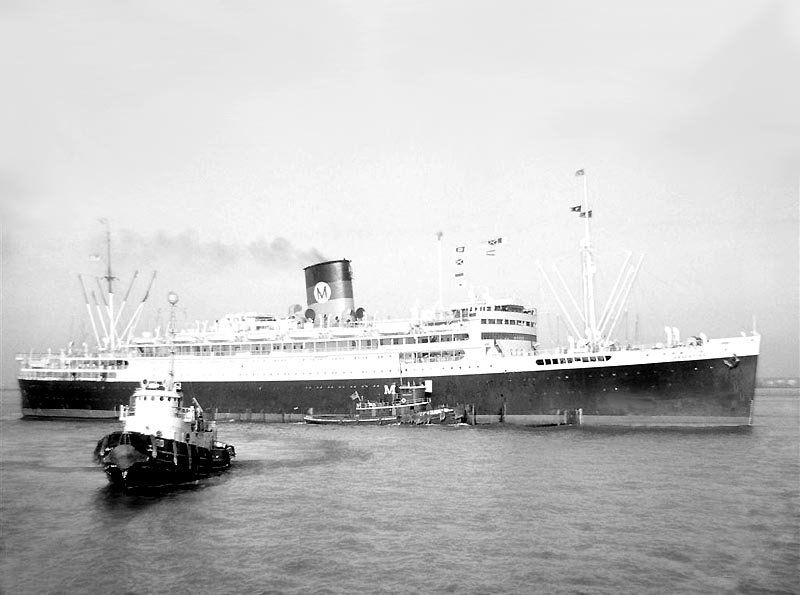
The SS Argentina seen in her post WW2 guise arriving
in New York
****************************
Page One … SS California,
Virginia & Pennsylvania - 1928
to 1938.
Page
Two … SS
Uruguay, Brazil & Argentina
- 1938 to 1946.
Page
Three … SS
Uruguay, Brazil & Argentina
- 1946 to 1964.
Also Visit … SS Brasil &
Argentina of 1968
“Blue Water Liners sailing to the distant shores.
I watched them come, I watched them go and I watched
them die.”
****************************
ENTER
OUR … ssMaritime
Main INDEX
Where
you will discover well over 700 Classic Passenger & Passenger-Cargo Liners!
ssMaritime.com & ssMaritime.net
Where the ships
of the past make history & the story of the
1914 built MV Doulos
If
requesting Passenger or Crew Lists or Sailing Schedules, I am sorry your
email will be Deleted!
I
receive hundreds of requests and I simply do not have any lists or schedules
available.
Please
Note: ssmaritime and associated
sites are 100% non-commercial and the author does not seek
funding or favours and never have and never will.
Photographs
on ssmaritime and associate pages are
either by the author or from the author’s private collection. In addition
there are some images and photographs that have been
provided by Shipping Companies or private photographers or collectors. Credit
is given to all contributors, however, there are some photographs provided to
me without details regarding the photographer or owner concerned. Therefore, I
hereby invite if owners of these images would be so kind to make them-selves
known to me; my email address can be only be found at www.ssmaritime.com in
order that due credit may be given.
ssMaritime is owned & © Copyright by Reuben Goossens -
All Rights Reserved




 -
-

 -
-
 -
-





